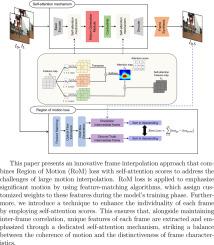Enhancing video frame interpolation with region of motion loss and self-attention mechanisms: A dual approach to address large, nonlinear motions
IF 5.5
2区 计算机科学
Q1 COMPUTER SCIENCE, ARTIFICIAL INTELLIGENCE
引用次数: 0
Abstract
Video frame interpolation is particularly challenging when dealing with large and non-linear object motions, often resulting in poor frame quality and motion artifacts. In this study, we introduce a novel dual-approach methodology for video frame interpolation that effectively addresses these complexities. Our method consists of two key components: a Region of Motion (RoM) loss and self-attention mechanisms. The RoM loss is designed to spotlight significant movements within frames. This is achieved by employing feature-matching techniques that assign tailored weights during the training process, ensuring that areas of intense motion are given priority. This is facilitated by the computation of optical flow, which identifies crucial feature points and highlights regions of significant motion for targeted enhancement. Our method incorporates self-attention mechanisms to maintain inter-frame continuity while emphasizing the unique attributes of individual frames. The self-attention scores reduce motion discrepancies and enhance the distinctiveness and texture quality of each frame. We validate the efficacy of our approach through extensive evaluations on benchmark datasets, including Vimeo-90K, Middlebury, UCF101, and SNU-Film.

利用运动损失区域和自我关注机制增强视频帧插值:解决大型非线性运动的双重方法
在处理大型非线性物体运动时,视频帧插值尤其具有挑战性,通常会导致帧质量差和运动伪影。在本研究中,我们介绍了一种新颖的视频帧插值双方法,可有效解决这些复杂问题。我们的方法由两个关键部分组成:运动区域(RoM)损失和自我关注机制。RoM 丢失的目的是突出帧内的重要运动。为此,我们采用了特征匹配技术,在训练过程中分配量身定制的权重,确保运动剧烈的区域得到优先处理。通过光流计算,可以识别关键特征点,并突出重要运动区域,从而有针对性地进行增强。我们的方法结合了自我关注机制,以保持帧间的连续性,同时强调单个帧的独特属性。自我关注得分可减少运动差异,并提高每个帧的独特性和纹理质量。我们在基准数据集(包括 Vimeo-90K、Middlebury、UCF101 和 SNU-Film)上进行了广泛的评估,验证了我们方法的有效性。
本文章由计算机程序翻译,如有差异,请以英文原文为准。
求助全文
约1分钟内获得全文
求助全文
来源期刊

Neurocomputing
工程技术-计算机:人工智能
CiteScore
13.10
自引率
10.00%
发文量
1382
审稿时长
70 days
期刊介绍:
Neurocomputing publishes articles describing recent fundamental contributions in the field of neurocomputing. Neurocomputing theory, practice and applications are the essential topics being covered.
 求助内容:
求助内容: 应助结果提醒方式:
应助结果提醒方式:


